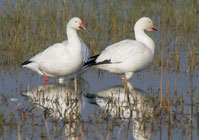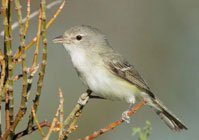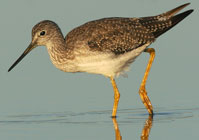Accomplishments
The CVJV partnership has earned an impressive record of accomplishment since its inception in 1988, and is making great progress towards meeting the objectives identified in its 2020 Implementation Plan.

 Bell’s Vireo
Bell’s VireoBy Joe Fleskes, Ph.D.
U.S. Geological Survey-Western Ecological Research Center

Most wetland habitats in the Central Valley of California rely on managed surface water supplies stored in reservoirs and delivered via a complex system to a wide array of competing water users. Water supplies vary with snow pack, temperature, and precipitation, all of which are projected to change substantially under some climate projections; land use and water management decisions can also greatly impact water supplies. Work is underway to help the Central Valley Joint Venture (CVJV) adapt its habitat conservation planning to account for potential changes in water supplies related to these factors.
Led by USGS-Western Ecological Research Center, a multi-partner project team is developing necessary data and adapting and applying the Central Valley Water Evaluation and Planning (WEAP) model to investigate impacts of various climate, urbanization, and water management scenarios on habitats and ecology of waterfowl and other waterbirds in the Central Valley. For each scenario, water supplies and demands are modeled in WEAP to estimate resulting landscape change. The amount, timing, and location of supported waterbird habitats based on these results are then included in bioenergetics models to evaluate adequacy of food supplies to support waterfowl populations under each scenario. Two bioenergetics modeling approaches are being used: 1) the traditional TRUEMET accounting of waterfowl food supplies and population demands; and 2) a spatially-explicit, agent-based modeling approach developed by U.C. Davis project partners Dr. John Eadie and staff that allows an evaluation of not only changes in the amount of habitat, but also changes in the spatial and temporal distribution of those habitats.
Beginning with Butte Basin in the northern Sacramento Valley, the project goal is to complete scenario evaluations for hydrological basins throughout the Central Valley. Initial modeling has indicated that under some scenarios, water supplies will not be adequate to maintain waterfowl habitat and food supplies at the levels necessary to support CVJV goal populations of waterfowl throughout the wintering interval. Results will be integrated into CVJV conservation planning and used in proposed work aimed at developing a holistic water allocation decision support tool that integrates models of hydropower and agricultural production economics with urban, fisheries, and waterbird habitat needs.
The current project team includes scientists from USGS-Western Ecological Research Center, Stockholm Environment Institute, University of California-Davis, Point Blue Conservation Science, and Ducks Unlimited. Project funding and logistical support have been provided by the California Landscape Conservation Cooperative, CVJV, U.S. Fish and Wildlife Service, California Department of Fish and Wildlife, USGS, and Delta Waterfowl.
This project reflects the long-term successful relationship between the CVJV and research organizations such as the USGS and is an example of the critical role that such collaborations play in gaining the information needed to guide planning and implementation of the CVJV.
Additional project information is available here.
The CVJV partnership has earned an impressive record of accomplishment since its inception in 1988, and is making great progress towards meeting the objectives identified in its 2020 Implementation Plan.

Follow these links to learn about some of the important bird conservation work happening in California's Central Valley.
